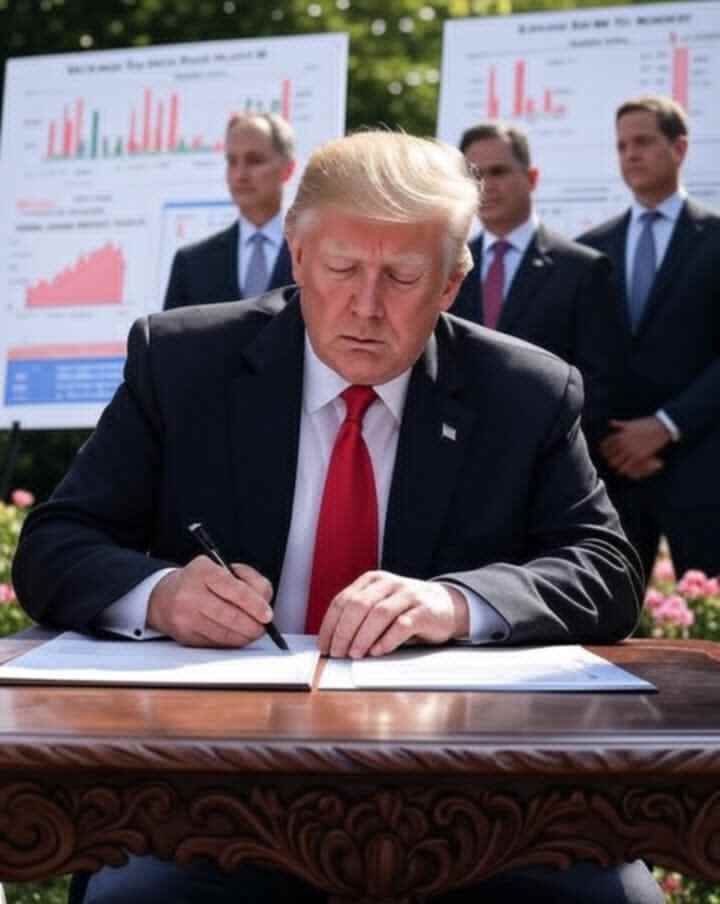Introduction: The Tariff Gamble
Trump’s Tariffs imposed sweeping tariffs, markets plunged and recession fears soared. Yet, the U.S. economy kept growing. Wall Street stopped reacting. Instead of collapse, many sectors adjusted. Some even benefited.
Now, with Trump’s tariffs back in the headlines and a possible return to office looming, it’s the perfect time to ask: What did they deliver?
This article explores the real effects of Trump’s tariffs — the promises, the economic response, and what experts say today. We’ll break down the facts, provide examples, and explain how this strategy changed U.S. trade policy.
What Trump’s Tariffs Have Caused So Far
Markets Initially Tanked
When Trump first announced tariffs, global markets stumbled. Businesses feared higher costs. Economists warned of a recession. For a moment, chaos ruled.
But over time, Trump’s tariffs became the norm. Markets stopped panicking. Wall Street began to shrug off new announcements.
Tax Revenue Surged
According to the U.S. Treasury Department, Trump’s tariffs have generated more than $100 billion in new revenue this year alone. Last month, tariff collections reached $27 billion.
Moody’s chief economist, Mark Zandi, predicts total revenue could top $300 billion by the end of 2025.
That’s nearly 1% of the U.S. GDP — a serious chunk of cash. These funds may help reduce budget deficits, although experts caution against relying on them long-term.
Trump’s Tariffs Prompted U.S. Investment Pledges
The message was clear: build in the U.S. or pay a price.
Still, these commitments are often long-term. Many include legal or political escape routes. Analysts warn that if tariff policies change, these pledges might too.
Trump’s Tariffs Hit Consumers — But Not Hard Yet
Toys, mostly imported, saw price spikes six times faster than just two months earlier. Clothing and furniture costs also climbed.
Inflation overall remained modest. In June, it hit 2.7% — up from May, but down from January’s 3%.
Experts say tariffs added to the pressure. But so far, the effect is limited.
What Are Trump’s Tariffs and How Do They Work?
What Is a Trump’s Tariffs
A tariff is a tax on imported goods. It makes foreign products more expensive. The goal is to:
- Protect local industries
- Encourage domestic manufacturing
- Generate government revenue
In short, it’s a tool to shift buying behavior and trade flows.
Why Did Trump Use Tariffs?
Trump’s tariffs were part of a broader “America First” strategy. He aimed to:
- Pressure countries like China and Japan
- Protect American jobs and industries
- Rebalance global trade
He believed other nations were taking advantage of the U.S. Tariffs, he said, would level the playing field.
How Are Tariffs Collected?
When goods enter the U.S., importers pay the tariffs directly to Customs and Border Protection. This money goes to the federal government.
It’s not foreign governments paying — it’s American companies. That cost often passes to consumers.
What’s the Downside?
Tariffs can backfire. They raise prices. They disrupt supply chains. And they can trigger retaliation — other countries may impose their own tariffs in return.
That can hurt farmers, exporters, and global partnerships.
How-To: Understand the Ongoing Impact of Trump’s Tariffs
1. Track Price Changes
Follow inflation data from the U.S. Bureau of Labor Statistics. Focus on sectors that rely heavily on imports:
- Consumer electronics
- Automobiles
- Apparel
- Furniture
- Toys
If Trump’s tariffs return or increase, these sectors may see more price jumps.
2. Watch for Policy Shifts
Trump’s trade policies have shifted multiple times. He imposed tariffs on China, then eased them. He removed some, then announced plans for 25%–50% tariffs on key trade partners.
Stay up to date. Watch:
- U.S. Trade Representative announcements
- White House briefings
- International responses (especially China, Japan, and South Korea)
3. Follow Legal Developments
Two major court rulings in May challenged parts of Trump’s tariff regime. Appeals could overturn key components. Legal instability makes long-term planning harder for businesses.
Investors and consumers alike should monitor these rulings. If courts strike down the tariffs, it could impact prices and trade flows.
4. Read Expert Opinions
Many economists agree that Trump’s tariffs have:
- Boosted short-term revenue
- Nudged companies toward U.S. manufacturing
- Caused moderate inflation
But opinions vary. Some see long-term gains. Others see disruption. Always seek balanced analysis.
5. Understand the Fed’s Role
Inflation triggers reactions from the Federal Reserve. If tariffs raise prices, the Fed may respond with higher interest rates.
This can slow borrowing, reduce spending, and risk a recession. Tariffs don’t act in a vacuum. Their economic impact depends on the Fed’s moves.
Conclusion: So, What Did Trump’s Tariffs Deliver?
Trump’s tariffs delivered some clear wins and mixed outcomes.
What they delivered:
- Massive tax revenue: Over $100 billion this year. Possibly $300 billion by 2025.
- New manufacturing promises: Major companies announced U.S. investments.
- Shift in global trade behavior: Countries responded, and new trade terms were debated.
But they also brought risks:
- Higher consumer prices: Especially for goods heavily reliant on imports.
- Uncertainty for businesses: Constant policy changes made long-term planning difficult.
- Legal challenges: Court decisions could invalidate parts of the tariff strategy.
Despite early fears, the economy didn’t collapse. Markets adjusted. Inflation rose — but not dangerously. The policy wasn’t a total failure or a total success.
It was complex, high-risk, and politically divisive.
✅ Trump’s Tariffs What You Must Do!
Stay informed. Follow tariff news. Ask your lawmakers how trade policy affects your wallet.
Whether or not you support Trump’s tariffs, one thing is certain — trade policy shapes your daily life. From what you pay for toys to how much you earn in wages, tariffs matter.
Make sure your voice counts. Learn more. Ask questions. And vote with a full understanding of the stakes.

